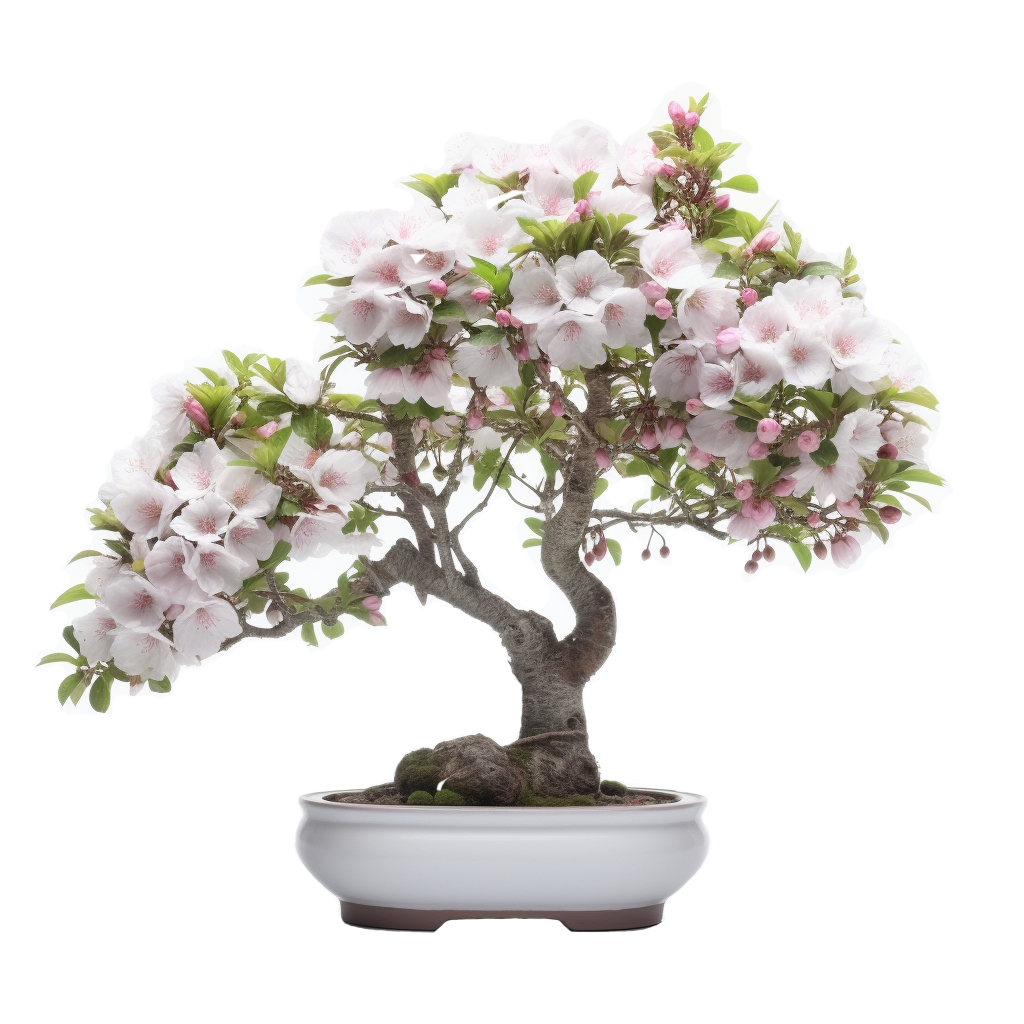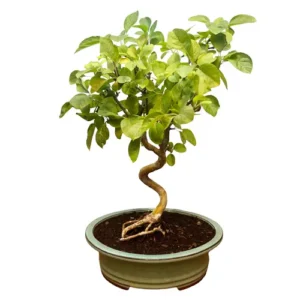Malus Halliana
Crab Apple Bonsai
The crab apple is a small deciduous tree which produces bright pink buds that open to white flowers. In the autumn these flowers change to tiny apples which sometimes hang on the tree for longer than the leaves.

Crab Apple Bonsai Care Tips
Placement
The crab apple is a hardy species that requires a lot of light and airflow to discourage mildew problems. Look for a spot that receives bright and full sun and note that it will not survive being kept indoors. Over winter, your crab apple will need some protection from frost, and we recommend using a cold frame or bringing it indoors to an unheated space such as a greenhouse.
Watering
There is no definitive guide to watering and it should be conducted on an observational schedule, not a routine. This means that it is important to keep an eye on the moisture levels of the soil to avoid over and under watering, both which can lead to dropping leaves and/or root death. The amount of water a bonsai requires depends on pot size, climate, airflow, soil and tree type so it is best to use your eyes and fingers to assess whether the soil is damp, wet or dry.
If the top inch or so of soil has dried, it is ready to be watered. When you water, try to get an even coverage over the roots and soil, allowing water to flow out from the bottom of the pot to ensure a good soaking.
If you are a first-time bonsai owner, another way to water is by submerging the entire pot in water until the bubbles stop. If you choose this method, be aware that your bonsai may not need watering for another two to four days, but this will depend on the factors mentioned above such as soil type, pot size and climate.
Be extra stringent when the tree is fruiting and water well; if it is allowed to dry up, the crab apple’s fruits will shrivel and drop off.
Feeding & Fertilising
Using fertiliser on your crab apple will help encourage healthy growth and this should be done periodically from once a week to every two months and only during the growing season. You can start adding Chrysal Liquid Bonsai Feed to your water from March until October and use weekly. Use Naruko Fertiliser Slow Release Bonsai Feed once every one to two months. With Buddhist Pine trees, less is more, and we tend to advise using half the recommended dosage to see how your Buddhist Pine reacts first.
Using a nitrogen-rich feed before, after or during flowering will encourage leaf and stem growth at the expense of fruiting. If growth is required over fruit, continue to feed fortnightly.
Pruning & Wiring
Pruning your bonsai is important not only to maintain or create an aesthetic style but also to manipulate the production of flowers and fruits.
In the spring, you can cut new shoots back to one or two leaves left on the stem. You should also remove fruits if there are too many because they weaken the tree. Remove all but one from each cluster.
After that, wait until late summer or autumn to prune, or until the leaves have fallen off, as this will avoid confusion between stems and flower buds. If you do not want your crab apple to produce fruits that year, cut off the flowers as soon as they die. We recommend that you only let your crab apple fruit once every two to three years to avoid weakening the tree.
Training your crab apple bonsai using wiring is possible on the younger, suppler branches but training older ones should be conducted with great care as the wood is very brittle. We recommend using wires with a thickness that matches the thickness of the branch: if the wire you choose is too thick you will damage the bark. If it is too thin, it won’t be effective.
Repotting
Repotting your tree is an important way to provide a fresh and suitable soil mix and ensure appropriate root health. Repot in springtime before the first signs of new growth. Generally, your crab apple will need to be re-potted annually if it is young, while older ones can stay in their pots for longer. However, you should always check if it has become root-bound before you change pots. You can do this by lifting the tree gently out of the pot by the main trunk and examining the root system. You will know it is ready if you can see that the roots are circling around each other and the pot. If, however, they still appear contained in the soil, you should place it back and wait until the following spring to check again.
Trees that are ready for repotting will require root pruning, a suitable new pot and appropriate soil mix.
When repotting, do not cut back the root mass by a large amount, and choose a well-draining soil mix that has a neutral or slightly higher PH value of 5-6 but not over 7. We tend to use a mixture of different speciality bonsai soils on our trees. Every species is different so please contact us for free soil-mix advice or to take advantage of our repotting service.
Bonsai trees aren’t only magnificent additions to an indoor oasis, they are more than capable of standing out in any garden. Many Bonsai species are incredibly hardy and withstand nature’s colder and damper turns with aplomb making them worthwhile outdoor plants. We have an extensive library of care guides for outdoor bonsai trees. It’s not about selecting the perfect bonsai, it’s about selecting the perfect bonsai for you.
Crab Apple Bonsai - Typical Queries
How do you take care of a Crab Apple Bonsai tree in the winter?
A Crab Apple Bonsai tree needs to be protected from frost and extreme cold in the winter, as it is not very hardy. You can either move your bonsai indoors to a cool and bright place, or cover it with a protective layer of mulch, straw, or bubble wrap. You should also reduce watering and stop fertilizing during the dormant period.
How much sunlight does a Crab Apple Bonsai need?
A Crab Apple Bonsai needs at least six hours of direct sunlight per day, preferably in the morning and evening. Avoid exposing your bonsai to the harsh midday sun, as it can scorch the leaves and flowers. You can also provide some shade during the hottest months to prevent overheating and dehydration.
Can a Crab Apple Bonsai be kept indoors?
A Crab Apple Bonsai can be kept indoors for short periods of time, such as during the winter or when displaying it for special occasions. However, it is not recommended to keep it indoors permanently, as it will not receive enough light and air circulation. A Crab Apple Bonsai is best suited for outdoor cultivation, where it can enjoy the natural seasons and climate.
How do you propagate a Crab Apple Bonsai?
You can propagate a Crab Apple Bonsai by seeds, cuttings, or grafting. Seeds can be collected from the fruits and sown in moist soil in autumn or spring. Cuttings can be taken from young and healthy branches in summer and planted in a pot with rooting hormone. Grafting can be done by attaching a scion from a desired variety to a compatible rootstock in late winter or early spring.
What are the common pests and diseases of a Crab Apple Bonsai?
Some of the common pests and diseases that can affect a Crab Apple Bonsai are aphids, spider mites, scale insects, caterpillars, leaf spot, powdery mildew, fire blight, and apple scab. You can prevent and treat these problems by keeping your bonsai healthy, clean, and well-watered. You can also use organic or chemical pesticides and fungicides, following the instructions carefully.









